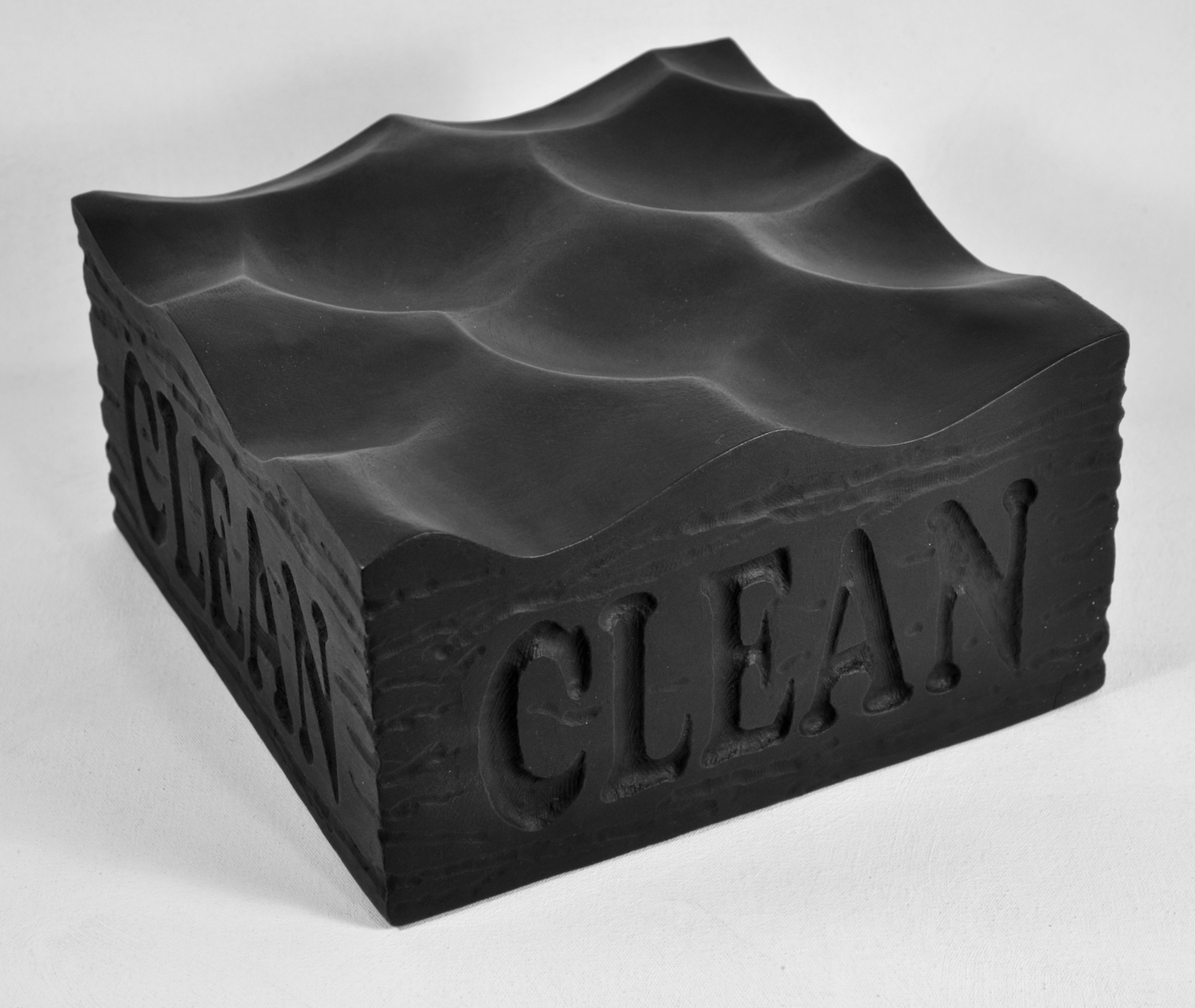Water is a recurring motif in his work. Water supports life. The precarious condition of the seas covering three-quarters of the surface of the earth is symptomatic of the health of the planet. Food, oxygen, and climate control are moderated by the oceans. The maintenance of this vital fluid is imperative. Lorio’s sculpture, Clean Water, ironically questions the purity of blacken seas.
THREE ACTIONS WITH THE PUBLIC
- Lorio’s socially engaged dialogue with the public manifested in the several solo shows presenting ocean contamination and other topical issues articulated in the sculptures for the past ten years.
- At each venue of the exhibition, he addressed this topic verbally in a lecture about the works. He plans to use this model in future exhibitions.
- As a professor of art, he presented the vulnerability of the planet’s seas in lectures to students as appropriate avenues for research for art making.
CURRENT SCULPTURE
With his current sculptural practice, Lorio uses a narrative of social concern to engage dialogue. His images convey his comments on the privilege of class, the plight of the immigrant, the curiosities of social hierarchy and ecological destruction. Frequently, he uses irony in these sculptures. Employing constructed and found forms especially wooden toys, carved and assembled works become poetic allusions incorporating the recognizable attributes of natural and manufactured objects. To him, toys are abstractions of grown-up possessions, professions, or spaces, which are to provide children role models. Collage and assemblage synthesize the imagery. More sculptures are available for viewing at
Lorio has shown this body of work from 2017 to 2011 in solo shows at the following institutions: Emory & Henry College, Emory, VA; Sandy Spring Museum, Olney, MD; Harnett Gallery, University of Rochester, Rochester, NY; Abington Art Center, Philadelphia, PA; Bridgewater College, Bridgewater, VA; Mezzanine Gallery, Delaware Division of the Arts, Wilmington, DE; Olin Art Gallery, Washington & Jefferson College, Washington, PA; Schoenherr Gallery, North Central College, Naperville, IL; Joan Derryberry Art Gallery, Tennessee Tech University, Cookeville, TN; Arts Center Gallery, Delaware State University, Dover, DE; Living Arts of Tulsa, Tulsa, OK; and Sloan Art Gallery, Lock Haven University, Lock Haven, PA.

Process: water images
The process of realizing the water image in his chosen medium, wood, affords an avenue for meditation. Lorio uses recycled wooden shelving as the medium for the work; the process of formation is slow and laborious. He considers of the grain of the wood like the current of water; the grain provides the strength of the structure. This strength is subtle, below the surface; hence, he paints them.
First, he makes a clay model of water which he cuts into a linear grid. The grid lines establish cross-sections in the clay model whose contours he draws on card stock. These drawn contours become the templates for cutting the wood. After cutting, Lorio laminates the sections of wood together. Once the glue has dried, he shapes the rough forms into more recognizable water shapes. His carving of water is not a rendering (exact copy) but a fiction of what is commonly associated with fluid and more broadly the sea.
BIOGRAPHY
Lorio was born and raised, through his teenage years, in New Orleans, Louisiana, USA. It framed his vision of life. It was and continues to be a place of extremes: beauty and decay, religion and ritual, custom and iconoclasm. From that experience, he acquired an excitement for visual matters: colors, forms and even artifacts.
At the time of the “9/11” bombing of the Twin Towers, NYC, Lorio was a professor at the University of Texas in Brownsville on the Mexican border; this sojourn expanded his vision. As an artist, he was carving elegant sculptures that ruminated on the cycles of nature. Viewing the curious lack of commitment for dialogue to offer solutions for the growing racial division, wealth inequality, and environmental decline in my own nation, he changed his insular focus of his art to more topical issues. Using found toys, he developed a series of sculptures that poignantly comment on adult concerns in the guise of ironic constructions of playthings.
EDUCATION & PROFESSIONAL COMMITMENT
Lorio holds a Master of Fine Arts Degree and a Bachelor of Arts Degree in Art Education. He taught on the university level for 33 years at four colleges retiring as an Associate Professor of Art. Presently, he pursuing his career as a sculptor full time. As a professor, his creative endeavor was awarded several grants: Individual Artist Fellowship (Established Artist), Delaware Division of the Arts, 2013; Ruth and Harold Chenven Foundation, New York, NY, 2011; Exceptional Merit Award, University of Texas at Brownsville, 2007; Texas Commission on the Arts/ University of Texas at Brownsville Travel Grant 2003 & 2006; Piedmont Hub Arts Council Grant, Greensboro, NC 2000-2001; Faculty Development Grant (Guilford College) 1997; North Carolina Individual Artist Fellowship, 1994-95; Southern Arts Federation Fellowship, 1993-94; North Carolina Artist Project Grant, 1993-94; Southern Arts Federation Fellowship, 1991-92; United Arts Council Fellowship Award, Greensboro, NC 1989-90; and a Michigan Council for the Arts Grant Award, 1986-87.
